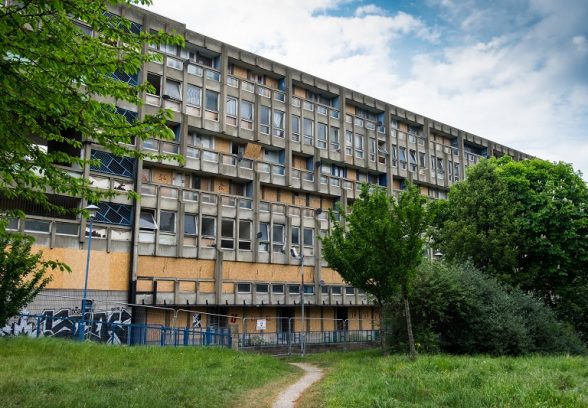This website uses cookies
This website uses cookies to enable it to function properly and to analyse how the website is used. Please click 'Close' to accept and continue using the website.



Plans by the V & A to salvage two maisonettes from London’s Brutalist Robin Hood Gardens is bitter sweet news to the Society which mounted a high profile campaign to save what was regarded as one of post war Britain’s most important social housing developments.
Director Catherine Croft commented: “RHG is an outstanding example of post war public housing, which C20 Society fought long and hard to get listed and to save; it could have been refurbished to provide good quality housing. We deeply regret its demolition which finally commenced this autumn. Keeping a small section is by no means an adequate way of preserving all that is important about a great building, but nevertheless we are delighted that some sense of the physical materiality of RHG will endure.
“It is very prescient of V&A to recognise the significance of the estate, both as an example of high modernist design, and as a highly controversial conservation disaster. We are sure that future generations will be inspired by the exhibit, and be as incredulous that demolition of RHG was allowed as we are today about the destruction of the Euston Arch.”
The campaign to save the complex, which was led by the Society and Building Design Magazine, was supported by a raft of high profile and international architects including Renzo Piano, Moshe Safdie, Lord Rogers, Zaha Hadid, Jean Nouvel, Frank Gehry, Rafael Viñoly, Ted Cullinan, Will Alsop, Amanda Levete and RIBA president Stephen Hodder.
We published a book Robin Hood Gardens Re-visions (https://www.amazon.co.uk/Robin-Hood-Gardens-Re-Visions-Architecture/dp/0955668719 ) to help raise the profile of the estate and worked with architect Sarah Wigglesworth to demonstrate how the existing buildings could have been successfully refurbished as an alternative to demolition.
Designed by architects of international stature, husband and wife team Alison and Peter Smithson, the 1972 complex comprised 213 flats built from precast concrete slabs. The development was made up of two long curved blocks arranged around a landscaped setting of raised mounds – a green oasis just a stone’s throw from the Blackwall Tunnel.
The Smithsons were the leading architectural thinkers of their generation in the UK and the most engaged with the international debate about housing and Modernism in Europe and America through their theorising, writing and building. They first came to prominence in 1950 when they won a competition to design a new secondary school in Hunstanton (grade II* in 1993). They developed the concept of ‘streets in the air’ in their competition entry for the Golden Lane Housing Estate, which they then put into practice at Robin Hood Gardens.

Become a C20 member today and help save our modern design heritage.